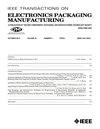Time–Frequency and Autoregressive Techniques for Prognostication of Shock-Impact Reliability of Implantable Biological Electronic Systems
IEEE Transactions on Electronics Packaging Manufacturing
Pub Date : 2008-05-27
DOI:10.1109/TEPM.2010.2078824
引用次数: 13
Abstract
In this paper, autoregressive and time-frequency-based techniques have been investigated to predict and monitor the damage in implantable biological electronics such as pacemakers and defibrillators. The approach focuses is on the pre-failure space and methodologies for quantification of failure in electronic equipment subjected to shock and vibration loads using the dynamic response of the electronic equipment. Presented methodologies are applicable at the system-level for identification of impending failures to trigger repair or replacement significantly prior to failure. Leading indicators of shock-damage have been developed to correlate with the damage initiation and progression in under variety of stresses in electronic systems. The approach is based on monitoring critical solder interconnects, and sensing the change in test-signal characteristics prior to failure, in addition to monitoring the transient strain characteristics optically using digital image correlation and strain gages. Previously, SPR based on wavelet packet energy decomposition and the Mahalanobis distance approach have been studied by the authors for quantification of shock damage in electronic assemblies ("Solder-joint reliability in electronics under shock and vibration using explicit finite element sub-modeling," P. Lall, et al. Proc. 56th ECTC, May-Jun. 2006, pp. 428-435, "Life prediction and damage equivalency for shock survivability of electronic components," P. Lall, et al. Proc. ITherm, May-Jun., 2006, pp. 804-816). In this paper, Autoregressive (AR), wavelet packet energy decomposition, and time-frequency (TFA) techniques have been investigated for system identification, condition monitoring, and fault detection and diagnosis in implantable biological electronic systems. One of the main advantages of the AR technique is that it is primarily a signal-based technique. Reduced reliance on system analysis helps avoid errors which otherwise may render the process of fault detection and diagnosis quite complex and dependent on the skills of the analyst. Results of the present study show that the AR and TFA-based health monitoring techniques are feasible for fault detection and damage-assessment in electronic units. Explicit finite-element models have been developed and various kinds of failure modes have been simulated such as solder ball cracking, package falloff, and solder ball failure.植入式生物电子系统冲击可靠性预测的时频和自回归技术
在本文中,研究了自回归和基于时间频率的技术来预测和监测植入式生物电子设备如起搏器和除颤器的损伤。该方法的重点是使用电子设备的动态响应来量化受到冲击和振动载荷的电子设备的故障的预失效空间和方法。提出的方法适用于系统级别,用于识别即将发生的故障,以便在故障发生之前触发维修或更换。冲击损伤的主要指标已经发展到与电子系统在各种应力下的损伤发生和进展有关。该方法基于监测关键焊点互连,并在故障前感知测试信号特性的变化,此外还使用数字图像相关和应变片光学监测瞬态应变特性。此前,作者已经研究了基于小波包能量分解和马氏距离方法的SPR,用于量化电子组件中的冲击损伤(“使用显式有限元子建模的冲击和振动下电子元件的焊接可靠性”,P. Lall等)。第56期,5 - 6月。2006,第428-435页,“电子元件冲击生存能力的寿命预测和损伤等效”,P. Lall等。5月- 6月。, 2006,第804-816页)。本文研究了自回归(AR)、小波包能量分解和时频(TFA)技术在植入式生物电子系统的系统识别、状态监测和故障检测与诊断中的应用。AR技术的主要优点之一是它主要是一种基于信号的技术。减少对系统分析的依赖有助于避免错误,否则可能会使故障检测和诊断过程变得非常复杂,并且依赖于分析人员的技能。研究结果表明,基于AR和tfa的健康监测技术在电子设备故障检测和损伤评估中是可行的。建立了显式有限元模型,并模拟了各种失效模式,如焊球破裂、封装脱落和焊球失效。
本文章由计算机程序翻译,如有差异,请以英文原文为准。
求助全文
约1分钟内获得全文
求助全文

 求助内容:
求助内容: 应助结果提醒方式:
应助结果提醒方式:


